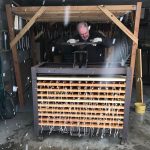Recently I had the opportunity to share in a long standing Capillupo Family tradition—making supersod (more commonly known as sopressata), a dry-cured Italian salami. Last year, while researching the Jinacio and Capillupo families, I contacted Andrew “Andy” Rogers. During our conversations he told me that his family continued the tradition of making supersod. I mentioned that I would be interested to learn the process, and he kindly invited me to the event last month; hosted by Andy in his home in Wheat Ridge.
The son of Eleanor Jinacio Rogers and Arthur Rogers, Andy Roger’s grandfather, John Anthony Jinacio, was a prominent member of Denver’s Little Italy. Born in Calabria in 1886, John Jinacio (along with his mother and siblings) joined his father Nicholas in American in 1896. By 1899, the Jinacio family was living on Mulberry Street in New York, and Nicholas was working as a blacksmith. Like numerous other Italian families, the name Jinacio was the Americanized version of Iannaccio (also spelled Innacci and Jannaccio on historic documents).
By 1905, Andy’s grandfather John Jinacio was working as a piano tuner in New York. Around 1908, John came west in search of greater employment opportunities. In Denver, John worked for the Mapel Music Co., McKannon Piano Co. and T. P. Pattison Music Co. Eventually he opened his own business on Navajo Street. According to a 1937 article, John Jinacio offered tuning, rebuilding and refinishing services. The same article noted that “In the tuning of pianos there is no one who offers a service that is superior to, or understands piano construction better than John A. Jinacio.” One of only a few piano tuners in the area, during the summer John Jinacio toured Colorado and Wyoming in his Model A Ford, tuning pianos in homes, on farms, in theaters and taverns.
In 1909, John A. Jinacio married Anna Lotito and in 1910 son Nicholas “Nick” was born, followed in 1912 by daughter Louise (who married Ernest “Ernie” Capillupo, owner of Ernie’s Supper Club for many years; today Ernie’s Supper Club is known as Ernie’s Bar, no longer owned by the Capillupo family), daughter Eleanor in 1914 (who married Arthur “Art” Rogers; Andy’s parents), daughter Helen born in 1916 (married Paul Gargaro) and daughter Josephine, born in Denver in 1920 (married Joseph Petraglia).
It is the memory of his family and heritage that keeps Andy (and his relatives) making supersod, year after year. Today, as in years past, the process of making the dry-cured salami remains basically the same, taking about eight weeks total. It begins with Andy ordering the supplies; he still uses his Uncle Ernie Capillupo’s recipe. He then confirms the date of the event; important as some relatives come from out of state to participate. Prior to the start of supersod weekend, Andy sets up the drying rack in his garage and transforms his basement into a family meat market—equipped with knives to trim the pork butts, a grinder, spices, a scale, tubs to mix the sausage in, and equipment for stuffing the sausage. The kitchen is also prepared for guests; food for a shared meal and wine to accompany the sausage tasting.
Day one of the event includes cleaning, cutting and tying off one end of the sausage casings. Day two participants gather early in the morning. After the meat preparation and grinding (around 300 pounds), the sausage and spices are mixed together thoroughly. The group then takes time to sample the cooked sausage and to make sure the mixture is hot enough; for many years Andy’s mom and Aunt Louise did the cooking. And just as Ernie Capillupo and others debated the amount of chili powder and red pepper used in the recipe, relatives today continue to analyze the “heat” in the sausage. The result of the debate this year….more spices were added to the mixture.
After completely mixing the sausage and spices, stuffing takes place. What seems like a simple job, is actually quite difficult; too much sausage and the casing breaks, too little and air bubbles form that damage the quality of the meat. After stuffing, each supersod is tied off, ready to hang. An all day event, the 2018 supersod weekend resulted in the production of around 314 supersods.
Five days later, I returned to Andy’s house and together we took down the supersods and put them in the press (originally owned by Ernie Capillupo who had it custom made as a supersod press). Pressed for five days, the supersods are then removed from the press and hung on the drying rack for six more weeks to finish curing. For long term storage (around two years), the supersods are put in a crock of oil or vacuum sealed and frozen.
The result of all the work is a slightly flattened, dry-cured salami that is delicious. It is nothing like the store-bought supersod; it’s much more flavorful. I enjoyed it with fruit and cheese. What I liked best about the supersod, was the experience of making it. The Capillupo family gathering, filled with food, laughter and loud voices, was just like being with my own family. I thank Andy and his relatives for welcoming me to supersod 2018, and for sharing with me the time honored tradition (and art) of making supersod.




